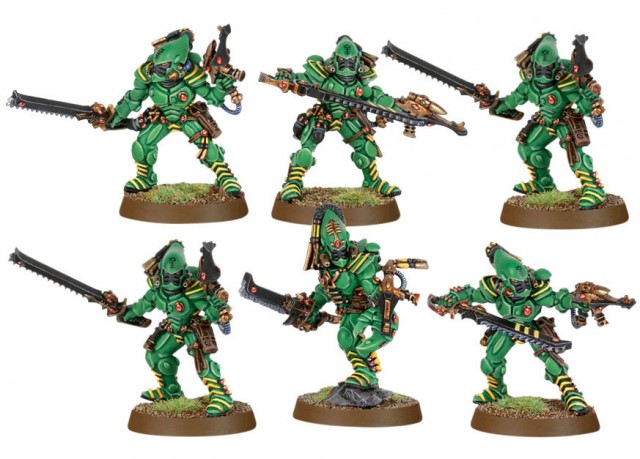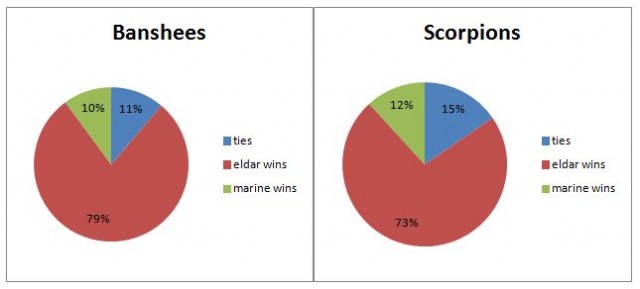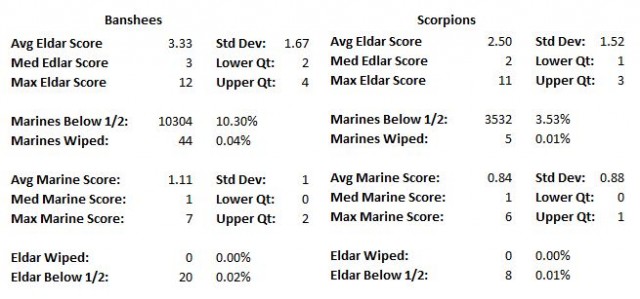If you have ever played Warhammer 40,000 or even visited the forums devoted to the game, you know that discussion of the day is usually “which unit is better”. Sometimes this is just plain ePenis wagging, bragging and blustering – but sometimes these debates have tactical and monetary merits. Especially when the parties involved in the discussion play the same army, and are arguing about effectiveness of certain units, and therefore their overall worth to you as a player. Warhammer miniatures cost real world money, and take time and effort to paint. A bad unit selection can set you back quite a bit.
Of course if you love the hobby and enjoy painting and converting, this is not a big deal. Even if you won’t field the unit in many battles, it will still look cool on your shelf as a display piece. But if you are putting together an army for tournament play for example, things like effectiveness matter.
Personally, I’m an Eldar player. For those of you who don’t know much about the game Eldar are essentially space elves. They are fast but fragile, and the have a wide range of very specialized, hard hitting, special-purpose units and almost no flexible all-purpose ones. As a result we love to discuss which of these units will fare the best under the most common set of battle scenarios. The most heated discussion usually involves close combat units.
Eldar are not great in melee. They are decent, and can cut through weaker foes, but often struggle facing elites. Space Marines – heavily armored super soldiers can usually mop the floor with your average Eldar unit unless you get a jump on them. And it just so happens that Marines are the most popular type of army out there. At an average tournament, chances are that 80% of players you face will play some flavor of marines – either vanilla, one of the four specialized chapters with their own special rules and disadvantages, or Chaos Space Marines (the evil flavor). So picking a close combat unit that can stand up to Marines is an important strategic decision.
Eldar have two main close combat specialist squads: Howling Banshees and Striking Scorpions. Banshees are usually thought of as the designated anti-Marine choice. They wield “power weapons” – energized can openers that ignore the impenetrable Marine armor which lets them shrug off over 60% of incurred damage. Unfortunately they are rather lightly armored, and do not pack enough punch to actually hurt the marines too badly, which makes them slightly less than imposing.
Striking Scorpions on the other hand are about a match for marines in terms of raw strength and punch-out force. They wear heavier armor which gives them more staying power, and they can score more attacks per round (up to 30 in perfect conditions at max size compared to up to 20 for a Banshee unit in the same circumstances). What they do not have, is Banshee ability to crack open Space Marine armor, which means a large number of their attacks will harmlessly bounce of of it.
You can probably see the dilemma here – what’s more effective: the ability to score a lot of wounds, many of which will be deflected, or the ability to score a few wounds but make them count. Many Eldar players have strong opinions one way or the other. Some skirt around the issue and just field both units in every battle (oh, Biel-Tan, when will you ever learn). As far as I know, no one has really made any statistical analysis on this subject. Most of what you read online is anecdotal evidence – stories of players who had particular luck against marines using either Banshees or Scorpions – or theoretical discussions of probability distributions for each unit.
I figured that the only way to settle this dispute once and for all, is to set up an experiment. Lets pit a unit of Scorpions and a unit of Banshees against your average Space Marine squad. Let’s roll the dice, record the results and see which one managed to kill more marines while loosing the least troops. Then let’s repeat it over and over and over again until we have a viable statistical sample. Let’s say 100,000 rounds should do the trick.
Methodology
Conducting such experiment using real models and real dice would be silly. I opted to simulate them in software. I wrote a small Python script (a little over 150 lines) that would emulate the first round of combat between an Eldar and Marine unit using the following assumptions:
- Both Eldar units fight against standard Space Marine Tactical Squad – not an Assault Squad. I figured tacticals are more common.
- Neither Eldar or Marine unit have any upgrades. This means no Exarchs, no powers, no sergeants, no special weapons and etc.
- The combat takes place on flat field, and the units line up perfectly – every model in base contact with an enemy. This means all attacks go in, there are no cover bonuses and etc..
- Eldar get to strike first due to their higher initiative
- Eldar and Marines are more or less matched when it comes to weapon skill so they always hit on 4 or more
- Banshees have two attacks each, and need a 5 to wound. Scorpions have three attacks and need only a 4.
- Marines forgo saves against Bashees but get the usual 3+ protection against the scorpions
- When Marines strike back they need only a 3 to wound. Banshees save on 4, Scorpions on 3.
I’m simulating dice rolls using the standard python method – using the random library like so:
def roll(over):
i = random.randint(1,6)
return (i>=over)
You can see the entire script on Github. I’m not going to copy and paste it here, because it’s to long:
Please note that I am only simulating the first round of combat during which Eldar have the biggest advantage. While a melee between Marines and Eldar will often last several turns, the first round is usually very important. Scoring enough wounds right of the get-go can cripple the opponents ability to deal damage later on, and even if they win in the end, it may render their unit unusable for purposes such as capturing objectives.
I figured that showing how each of the units will fare in their first round will be enough to judge their overall effectiveness.
When judging the results, I do it the way you would normally resolve a round: I compare how many unsaved wounds was scored on both sides. If Eldar scored more wounds than they incurred casualties then they win the round. If both sides score the same, its a tie. Otherwise Marines win.
Results
When I started running this experiment, I expected to see a large skew in favor of either Banshees or the Scorpions. Because of all the heated discussions about their effectiveness I witnessed over the years I wanted to see one or the other side of the argument validated. Unfortunately, it seems that both units are remarkably balanced. After 100,000 rounds here is the overall spread of wins, losses and ties:
Over 100,000 runs, Banshees won a round only 6% more often than Scorpions. On the other hand Scorpions tied a little bit more often – most likely due to their superior armor. The difference between the two units it is almost insignificant at this scale. Both units are quite adept at dominating the enemy on the first round, but neither one seems to be better at it than the other. Lets delve a little bit deeper and see some more statistical data on this simulation:
Over the 100,000 trials both units killed on average between 2-3 Marines. Banshees killed a little bit more efficiently (nearing almost 4 marines on average, 3 being the median score) with scorpions averaging a little below 3 (2 median). Looking at that data alone, you could summarize that the brute strength and ferocity of Scorpion attack is essentially a perfect match of the Banshee can opening skills. Or rather, in the long run Marine armor is not as effective as one would think.
I expected Scorpions to incur significantly less casualties due to their heavy armor, but surprisingly this turned out not to matter all that much. Both units lost on average one man in the first turn showing that the Scorpions do not have a huge advantage over the Banshees in this department.
Banshees did show a slight edge in their ability to bring down the Marine unit below half strength on the first turn. They have accomplished this feat roughly 10% of the time, to Scorpions measly 3%. Of course, both cases are rather statistically insignificant. Most rounds ended in a close victory for the Eldar, but with Marine unit still over half strength. The rounds in which Eldar stomped the Marines into the ground, eradicating the entire squad were extremely rare – 44 occurrences for Banshees and 5 for Scorpions.
I urge you not to take my word for this. You can find my data sets on Github alongside the code. They are tab-separated text files that can be easily imported into Excel, or parsed with awk/sed for further analysis:
Here is the clarification for the headers:
eh = eldar hits ew = eldar wounds mh = marine hits mw = marine wounds de = dead eldar dm = dead marines
Summaries are underneath the raw data. You can use these files to run more in depth analysis than me. Also feel free to inspect the code, correct any mistakes you see and run such experiment on your own.
I have ran this 100,000 round test several times to make sure the numbers I got were not a fluke. Remarkably the ratio of wins to losses remained almost the same on subsequent runs.
Based on the statistical data I can conclude that there is virtually no tactical advantage in using Banshees over Scorpions. Both units are equally effective at fighting Marines. In fact, these results suggest that Scorpions are a more well rounded choice for tournament play. While they are about equal to Banshees in effectiveness against Marines they do have superior strength and armor making them much more dangerous to less armored opponents. While Banshees specialize in cracking open Marine power armors they do not pack enough punch to do well against lightly armored, ferocious melee fighters.
Further Research
This experiment was rather limited by the scope. For one, it only looked at the first round of combat – mostly to keep things simple. While in many cases first round tends to be decisive, I have witnessed enough nearly miraculous third or fourth turn come-backs to completely discard them. To get a full picture, it would be worth while to extend the python script to simulate entire combat sequence – from start to a failed moral e check or annihilation.
In addition, part of the Eldar Aspect Warrior effectiveness stems from their Exarchs – an upgraded unit leaders, who can use more powerful weapons and bestow a range of special effects on their unit. It is likely that combination of weapons and Exarch powers could easily skew the balance toward either Banshees or Scorpions.
Perhaps I will investigate these things in another post.




Heh. That was actually kind of interesting. Some time since I have played though (Marines – go figure), but it was fun. Also, I think perhaps you must be the person on the internet with the highest quantity of nerdy interests (This is meant as awe).
By the way I would like to see how those specialized melee eldars fared against specialized melee marines.
@ Iodine:
To be honest I have not played a real game of 40k in a few years now. I still like to keep up with the hobby from time to time though. I hit up /r/Warhammer and sometimes venture into various forums for rumors. :)
My experience against assault squads (which usually come with a pimped out Sargent) the aspect warriors usually don’t survive longer than a few turns, but it would be interesting to simulate it.
First of all great experiment!
nice combination of simulation and hobby:)
If you don’t mind I share another idea which I think is nice to know when reading
the above (specially for those who don’t like to write computer simulations)..I actually do:)
An other idea is also (no guarantee that I didn’t make any mistakes):
You don’t need to simulate to investigate that problem, you can calculate this analytically.
This is surely correct, but my attempt to do so very quickly might not be.
The probability to kill a marine with one attack of a banshee is the product of the probabilities
probability to hit marine = 1/2 (4+ on a dice)
probability to inflict if hit = 1/3 (5+ on a dice)
probability to die if inflicted = 1 (no armour saves against energy weapon)
so the probability (product of the above) is
the probability to kill a marine with one attack from a banshee = 1/6
We can now wright down the analytic formula of: the expectation value E
of the number of killed marines “E” with “N” attacks from howling banshees, which is
E= sum_{i=0}^{i=N} (1/6)^i * (5/6)^(N-i) .
Programming this is trivial and it is nice to plot the expectation value of killed marines
against the number of Banshees. Getting the loss on the eldar side is now straight forward by calculating “E” as mentioned above and look how many marines survived and simply applying the same formula but for the Marine probability to kill a Banshee. Doing the same for the Scorpions will then give the results of your experiment (if simulated an infinite amount of times)
On the other hand it is now also easy to see how one can calculate not the expectation value but also other things like the probability of “n” marines getting killed by “x” banshees.
The same goes with all other experiments of that kind. It becomes interesting when looking at how much units cost and one can start adding weight factors. Like Expectation values of killed enemies per point..
Hope that was slightly interesting…
@ jack:
Wow nice. I didn’t even think about doing it this way. I just went “let’s do experiments and see what comes out”. Mathematical modeling of the problem is greatly appreciated.
I need to correct the formula above (since I had time to think about it more carefully)
E= sum_{i=0}^{i=N} (1/6)^i * (5/6)^(N-i) *i *(n choose i).
If I have time I will try to do a deeper analysis of troops in the Warhammer universe. I just hope people use the models they like and not just the most efficient ones.
This way is interesting, but in the end its up to weather theice go your way or not. So in saying that has anyone thought of just getting a full squad of banshees, scorpions and marines and just rolling some dice to see how they go, noting down the combat res over 4 rounds of combat and doing it for a couple of weeks at random times when your luck is better or worse, would make this test come out more real than a maths equasion on paper.